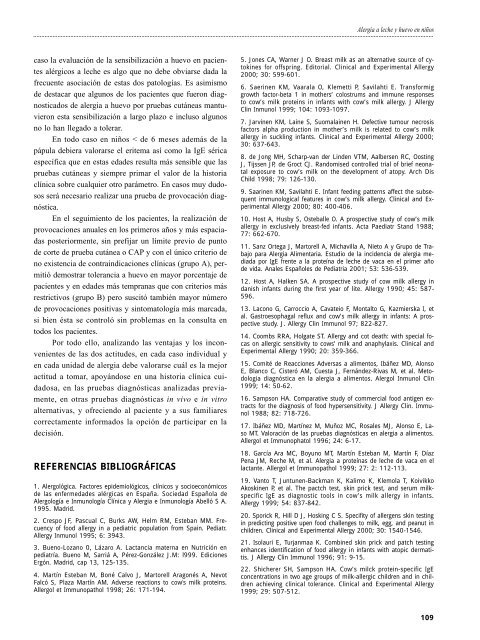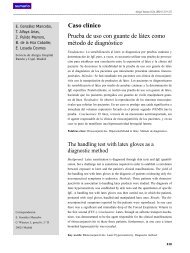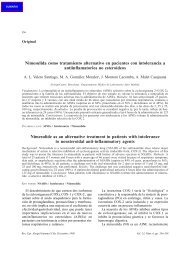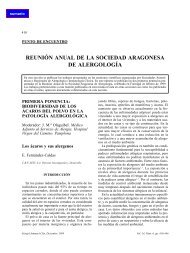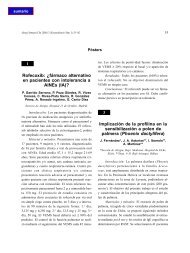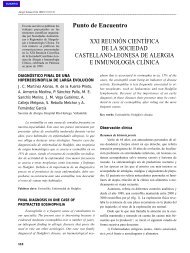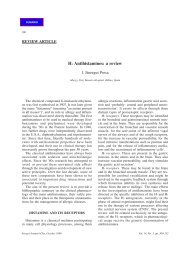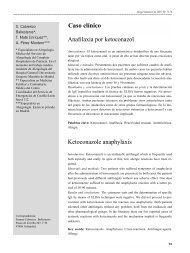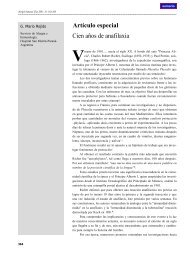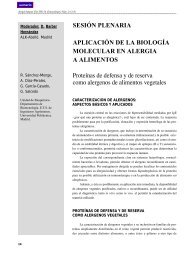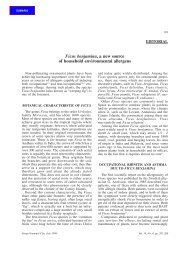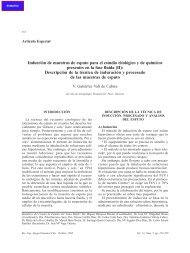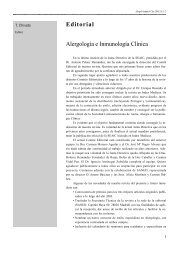Alergia a leche y huevo en niños - Alergología e Inmunología ...
Alergia a leche y huevo en niños - Alergología e Inmunología ...
Alergia a leche y huevo en niños - Alergología e Inmunología ...
Create successful ePaper yourself
Turn your PDF publications into a flip-book with our unique Google optimized e-Paper software.
caso la evaluación de la s<strong>en</strong>sibilización a <strong>huevo</strong> <strong>en</strong> paci<strong>en</strong>tes<br />
alérgicos a <strong>leche</strong> es algo que no debe obviarse dada la<br />
frecu<strong>en</strong>te asociación de estas dos patologías. Es asimismo<br />
de destacar que algunos de los paci<strong>en</strong>tes que fueron diagnosticados<br />
de alergia a <strong>huevo</strong> por pruebas cutáneas mantuvieron<br />
esta s<strong>en</strong>sibilización a largo plazo e incluso algunos<br />
no lo han llegado a tolerar.<br />
En todo caso <strong>en</strong> <strong>niños</strong> < de 6 meses además de la<br />
pápula debiera valorarse el eritema así como la IgE sérica<br />
específica que <strong>en</strong> estas edades resulta más s<strong>en</strong>sible que las<br />
pruebas cutáneas y siempre primar el valor de la historia<br />
clínica sobre cualquier otro parámetro. En casos muy dudosos<br />
será necesario realizar una prueba de provocación diagnóstica.<br />
En el seguimi<strong>en</strong>to de los paci<strong>en</strong>tes, la realización de<br />
provocaciones anuales <strong>en</strong> los primeros años y más espaciadas<br />
posteriorm<strong>en</strong>te, sin prefijar un límite previo de punto<br />
de corte de prueba cutánea o CAP y con el único criterio de<br />
no exist<strong>en</strong>cia de contraindicaciones clínicas (grupo A), permitió<br />
demostrar tolerancia a <strong>huevo</strong> <strong>en</strong> mayor porc<strong>en</strong>taje de<br />
paci<strong>en</strong>tes y <strong>en</strong> edades más tempranas que con criterios más<br />
restrictivos (grupo B) pero suscitó también mayor número<br />
de provocaciones positivas y sintomatología más marcada,<br />
si bi<strong>en</strong> ésta se controló sin problemas <strong>en</strong> la consulta <strong>en</strong><br />
todos los paci<strong>en</strong>tes.<br />
Por todo ello, analizando las v<strong>en</strong>tajas y los inconv<strong>en</strong>i<strong>en</strong>tes<br />
de las dos actitudes, <strong>en</strong> cada caso individual y<br />
<strong>en</strong> cada unidad de alergia debe valorarse cuál es la mejor<br />
actitud a tomar, apoyándose <strong>en</strong> una historia clínica cuidadosa,<br />
<strong>en</strong> las pruebas diagnósticas analizadas previam<strong>en</strong>te,<br />
<strong>en</strong> otras pruebas diagnósticas in vivo e in vitro<br />
alternativas, y ofreci<strong>en</strong>do al paci<strong>en</strong>te y a sus familiares<br />
correctam<strong>en</strong>te informados la opción de participar <strong>en</strong> la<br />
decisión.<br />
REFERENCIAS BIBLIOGRÁFICAS<br />
1. Alergológica. Factores epidemiológicos, clínicos y socioeconómicos<br />
de las <strong>en</strong>fermedades alérgicas <strong>en</strong> España. Sociedad Española de<br />
<strong>Alergología</strong> e <strong>Inmunología</strong> Clínica y <strong>Alergia</strong> e <strong>Inmunología</strong> Abelló S A.<br />
1995. Madrid.<br />
2. Crespo JF, Pascual C, Burks AW, Helm RM, Esteban MM. Frecu<strong>en</strong>cy<br />
of food allergy in a pediatric population from Spain. Pediatr.<br />
Allergy Inmunol 1995; 6: 3943.<br />
3. Bu<strong>en</strong>o-Lozano 0, Lázaro A. Lactancia materna <strong>en</strong> Nutrición <strong>en</strong><br />
pediatría. Bu<strong>en</strong>o M, Sarriá A, Pérez-González J.M: l999. Ediciones<br />
Ergón. Madrid, cap 13, 125-135.<br />
4. Martín Esteban M, Boné Calvo J, Martorell Aragonés A, Nevot<br />
Falcó S, Plaza Martín AM. Adverse reactions to cow's milk proteins.<br />
Allergol et Immunopathol 1998; 26: 171-194.<br />
<strong>Alergia</strong> a <strong>leche</strong> y <strong>huevo</strong> <strong>en</strong> <strong>niños</strong><br />
5. Jones CA, Warner J O. Breast milk as an alternative source of cytokines<br />
for offspring. Editorial. Clinical and Experim<strong>en</strong>tal Allergy<br />
2000; 30: 599-601.<br />
6. Saerin<strong>en</strong> KM, Vaarala O, Klemetti P, Savilahti E. Transformig<br />
growth factor-beta 1 in mothers’ colostrums and immune responses<br />
to cow’s milk proteins in infants with cow’s milk allergy. J Allergy<br />
Clin Inmunol 1999; 104: 1093-1097.<br />
7. Jarvin<strong>en</strong> KM, Laine S, Suomalain<strong>en</strong> H. Defective tumour necrosis<br />
factors alpha production in mother’s milk is related to cow’s milk<br />
allergy in suckling infants. Clinical and Experim<strong>en</strong>tal Allergy 2000;<br />
30: 637-643.<br />
8. de Jong MH, Scharp-van der Lind<strong>en</strong> VTM, Aalbers<strong>en</strong> RC, Oosting<br />
J, Tijss<strong>en</strong> JP, de Groct CJ. Randomised controlled trial of brief neonatal<br />
exposure to cow’s milk on the developm<strong>en</strong>t of atopy. Arch Dis<br />
Child 1998; 79: 126-130.<br />
9. Saarin<strong>en</strong> KM, Savilahti E. Infant feeding patterns affect the subsequ<strong>en</strong>t<br />
immunological features in cow’s milk allergy. Clinical and Experim<strong>en</strong>tal<br />
Allergy 2000; 80: 400-406.<br />
10. Host A, Husby S, Osteballe O. A prospective study of cow’s milk<br />
allergy in exclusively breast-fed infants. Acta Paediatr Stand 1988;<br />
77: 662-670.<br />
11. Sanz Ortega J, Martorell A, Michavilla A, Nieto A y Grupo de Trabajo<br />
para <strong>Alergia</strong> Alim<strong>en</strong>taria. Estudio de la incid<strong>en</strong>cia de alergia mediada<br />
por IgE fr<strong>en</strong>te a la proteína de <strong>leche</strong> de vaca <strong>en</strong> el primer año<br />
de vida. Anales Españoles de Pediatria 2001; 53: 536-539.<br />
12. Host A, Halk<strong>en</strong> SA. A prospective study of cow milk allergy in<br />
danish infants during the first year of lite. Allergy 1990; 45: 587-<br />
596.<br />
13. Lacono G, Carroccio A, Cavateio F, Montalto G, Kazmierska I, et<br />
al. Gastroesophagal reflux and cow’s milk allergy in infants: A prospective<br />
study. J. Allergy Clin Immunol 97; 822-827.<br />
14. Coombs RRA, Holgate ST. Allergy and cot death: with special focas<br />
on allergic s<strong>en</strong>sitivity to cows’ milk and anaphylaxis. Clinical and<br />
Experim<strong>en</strong>tal Allergy 1990; 20: 359-366.<br />
15. Comité de Reacciones Adversas a alim<strong>en</strong>tos, Ibáñez MD, Alonso<br />
E, Blanco C, Cisteró AM, Cuesta J, Fernández-Rivas M, et al. Metodologia<br />
diagnóstica <strong>en</strong> la alergia a alim<strong>en</strong>tos. Alergol Inmunol Clin<br />
1999; 14: 50-62.<br />
16. Sampson HA. Comparative study of commercial food antig<strong>en</strong> extracts<br />
for the diagnosis of food hypers<strong>en</strong>sitivity. J Allergy Clin. Immunol<br />
1988; 82: 718-726.<br />
17. Ibáñez MD, Martínez M, Muñoz MC, Rosales MJ, Alonso E, Laso<br />
MT. Valoración de las pruebas diagnósticas <strong>en</strong> alergia a alim<strong>en</strong>tos.<br />
Allergol et Immunophatol 1996; 24: 6-17.<br />
18. García Ara MC, Boyuno MT, Martín Esteban M, Martín F, Díaz<br />
P<strong>en</strong>a JM, Reche M, et al. <strong>Alergia</strong> a proteínas de <strong>leche</strong> de vaca <strong>en</strong> el<br />
lactante. Allergol et Immunopathol 1999; 27: 2: 112-113.<br />
19. Vanto T, Juntun<strong>en</strong>-Backman K, Kalimo K, Klemola T, Koivikko<br />
Akoskin<strong>en</strong> P, et al. The pactch test, skin prick test, and serum milkspecific<br />
IgE as diagnostic tools in cow’s milk allergy in infants.<br />
Allergy 1999; 54: 837-842.<br />
20. Sporick R, Hill D J, Hosking C S. Specifity of allerg<strong>en</strong>s skin testing<br />
in predicting positive up<strong>en</strong> food chall<strong>en</strong>ges to milk, egg, and peanut in<br />
childr<strong>en</strong>. Clinical and Experim<strong>en</strong>tal Allergy 2000; 30: 1540-1546.<br />
21. Isolauri E, Turjanmaa K. Combined skin prick and patch testing<br />
<strong>en</strong>hances id<strong>en</strong>tification of food allergy in infants with atopic dermatitis.<br />
J Allergy Clin Immunol 1996; 91: 9-15.<br />
22. Shicherer SH, Sampson HA. Cow’s milck protein-specific IgE<br />
conc<strong>en</strong>trations in two age groups of milk-allergic childr<strong>en</strong> and in childr<strong>en</strong><br />
achieving clinical tolerance. Clinical and Experim<strong>en</strong>tal Allergy<br />
1999; 29: 507-512.<br />
109


